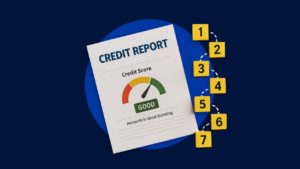Goodwill letters to creditors: Do they work?




Key takeaways
- A goodwill letter is a formal written request asking a creditor to remove a negative mark, like a late payment, from your credit report.
- Goodwill letters are most effective if your payment history and credit is generally in good standing.
- Lenders are more likely to respond positively to the letter if the late payment was a one-time incident like an auto payment mix-up or family emergency.
- Lenders aren’t required to reply to a goodwill letter or may have policies against doing so.
Sometimes, despite all of your efforts to pay bills on time, life’s busyness can cause you to miss a payment. That’s always bad news for your credit score, since payment history carries the most weight for how high – or low – your credit score is.
A goodwill letter may allow you to correct a one-time mistake, reversing the damage done to your credit by a missed payment. While there’s no guarantee or requirement for a lender to respond, they may be willing to make a correction if you have a history of paying your bills on time.
What is a goodwill letter?
A goodwill letter is a formal letter sent to a creditor to remove a negative item from your credit report. You’re essentially asking for a break, or “goodwill”, for an oversight that you accept responsibility for, which was an isolated event.
If the lender has a goodwill policy, they may be willing to make the requested changes as a gesture of goodwill. While removing a negative item from your credit report will most certainly improve your credit score, lenders aren’t under any obligation to do so.
In fact, many larger lenders and credit card issuers may have a policy against accepting goodwill letters because of regulations that require them to provide accurate reporting of your payment history to credit bureaus. Your success may depend largely on your relationship and payment history before the late payment occurred.
A goodwill letter is not the same as a credit dispute. A dispute is when you don’t agree with something that is on your credit report. A goodwill letter asks creditors to remove a negative report for something you admit was your mistake.
When should you write a goodwill letter?
You have the best chance for success with a goodwill letter if your payment history has been perfect otherwise, and you are not experiencing any financial hardship now.
The sooner you send the letter after the oversight, the better. That will show the lender you take your relationship with the lender and your credit obligations seriously.
Check with the lender to see how long they take to respond to correspondence. There’s no required timeline, but it’s best to give them at least a few weeks to consider your request. If more than a month goes by, follow up by phone, email or through their app, if applicable.
Reasons lenders may be willing to consider
- Bank auto payment changes: If you switched banks or had to close down an account due to account fraud, be prepared to provide evidence of the account change or fraud correspondence.
- Unexpected financial hardship: A large auto repair bill or medical deductible that depleted your cash reserves temporarily.
- A family medical emergency: If you or a family member was in the hospital for an extended period due to an emergency.
- Address forwarding oversights: This is only likely to be valid if you only receive paper bills in the mail.
- Proof you never made a late payment: Documentation such as canceled checks or a bank statement may allow the lender to remove a late payment if it’s clear the payment was made within the due date.
7 Tips for writing an effective goodwill letter
A goodwill letter should provide the details of what occurred and accept responsibility for the mistake. Emphasizing the value you place on managing credit responsibly and the relationship with the lender will help strengthen your case, along with the following tips:
- Be respectful: Since you’re essentially asking the lender for a favor, your letter should be polite and professional.
- Don’t overshare: The lender doesn’t need (or want) very personal details about all the circumstances that led to the issue. Simply state the facts and timelines, and support them with any relevant proof.
- Accept fault: Acknowledging the mistake on your part may motivate the lender to consider your request as opposed to complaining or making excuses for how someone else potentially caused the issue.
- Explain why it won’t happen again: Lenders want reassurance that this is a one-time occurrence. Sharing a recent raise, bonus or tax refund in your bank account may help show your finances are better now. If it was due to oversight, refer to a history of on-time payments with the lender.
- Clearly state your request: Tell the lender what you’d like them to do, whether it is removing a late payment from your credit report, waiving a late fee or some other leniency.
- Provide documentation: Add proof of your situation and how it’s improved with the letter, if you have it.
- Share how you value doing business with the lender: If you’ve been a customer for several years, always paid on time, have other accounts with them, let them know. Lenders are generally happy to accommodate a loyal customer.
Sample goodwill template letter
- [Your Name]
- [Your Address]
- [Phone Number]
- [Email Address]
- [Date]
- [Creditor/Lender’s Name]
- [Creditor/Lender’s Address]
- Dear [Creditor/Lender’s Name],
- I am writing to address a recent late payment on my account with [Creditor/Lender’s Name].
- [Explain the circumstances that led to the late payment or negative item on your credit report. Be honest and provide relevant details. Note any documentation you can enclose.]
- I take full responsibility for the late payment. [Acknowledge any mistakes made and express genuine remorse for any inconvenience caused.]
- Despite this incident, I have maintained a positive payment history with [Creditor/Lender’s Name]. [Highlight any previous instances of on-time payments or your long-standing relationship with the creditor.]
- I assure you that this late payment was an isolated incident. [Reassure the creditor that the late payment was not typical of your financial behavior and explain any steps taken to prevent future issues.]
- I kindly request [specific action, such as the removal of the negative item from your credit report, a waiver of late fees or another form of leniency].
- Thank you for taking the time to consider my request. I appreciate your understanding and cooperation in this matter.
- Sincerely,
- [Your signature]
3 Communication options
It’s best to contact your lender to find out the best way to send your goodwill letter. Lenders typically offer phone, email or postal mail options.
By phone
A phone call to a lender’s customer service department should be your first effort to communicate your goodwill letter plans. A representative may be able to give you an idea of their goodwill policies and suggest documentation you’ll need to provide with the letter.
By email
Many lenders have adopted electronic communications. They may have a dedicated email address for goodwill or payment-related issues. With an email, you have a date-stamped start date for your initial communications, and you can keep track of follow ups by archiving your efforts to reach the lender.
By postal mail
If the lender only accepts mail correspondence, see if they will accept certified mail. Although it costs a bit more, it ensures you know that your letter was in fact received. Once you confirm receipt, you can set up automated follow-up messages for yourself.
What should you do if your goodwill letter is declined?
If the lender denies your goodwill request, try to get as much detail as to why it was declined.
Ask if there was any documentation missing that would allow them to accept the request. However, in some cases, you may need to consider debt management alternatives:
- Credit counseling may allow you to have someone else work with you to strengthen your letter. It can also be a benefit if you’re having trouble paying bills.
- Dispute the account with the bureaus if you provided documents that show you were not late, and if the lender doesn’t accept, consider going straight to credit bureaus for help.
-
Credit repair services may give you strategies to dispute accounts on your behalf, as long as you can afford the cost of their services. Be aware that this field is rife with scammers, and many of the services they offer can often be done on your own.
Bottom line
Managing credit along with all of your other financial obligations can be challenging, especially if you have a busy life. One late payment can have a significant impact on your credit score, which can greatly affect your ability to get future loans, such as mortgages and car loans, even car and home insurance. Because of this, it’s worth doing everything possible to maximize your score. If you had one blip on an otherwise unblemished credit relationship with a lender, a goodwill letter may be worth the effort.
Frequently asked questions
Why we ask for feedback Your feedback helps us improve our content and services. It takes less than a minute to complete.
Your responses are anonymous and will only be used for improving our website.




